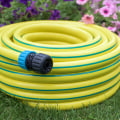Caring for your lawn involves several key practices to maintain its health and appearance. Regular mowing at the appropriate height helps promote growth and discourage weeds. Proper watering, typically in the early morning, ensures deep root development and resilience against drought. Fertilizing with the right nutrients during the growing season enhances color and growth. Aeration prevents soil compaction, while weed control and pest management are crucial for overall health. Adjusting care for different seasons is important, such as raising mowing height in summer. For a complete outdoor solution, you can also explore reliable fencing solutions at https://securefencecompany.com, adding both beauty and functionality to your outdoor space.
Proper lawn care is essential for maintaining a lush, vibrant, and healthy outdoor space. A well-kept lawn not only enhances the aesthetic appeal of your property but also provides a comfortable area for relaxation, play, and social gatherings. To ensure your lawn thrives throughout the seasons, it's important to follow a comprehensive care routine that addresses various aspects of maintenance.
1. Mowing: Regular and proper mowing is fundamental to lawn health. Set your mower blades to a height that ensures no more than one-third of the grass blade is removed in a single cut. Mowing too short can stress the grass and make it more susceptible to pests and diseases.
2. Watering: Proper watering practices are key to sustaining a healthy lawn. Water deeply and infrequently, preferably in the early morning. This allows the water to penetrate deeply into the soil, encouraging deep root growth and making your lawn more resilient to drought conditions. Avoid overwatering, which can lead to shallow root systems and promote weed growth.
3. Fertilizing: Regular fertilization provides essential nutrients to support healthy grass growth. Choose a balanced fertilizer with the appropriate ratio of nitrogen, phosphorus, and potassium. Follow the recommended application rates for your specific grass type and local climate. Applying fertilizer during the growing season, usually spring and fall, helps maintain a rich green color and strong growth.
4. Aeration: Lawn aeration involves perforating the soil with small holes to alleviate compaction and improve air, water, and nutrient penetration to the grassroots. This practice helps maintain a healthier root system and overall lawn vitality. Aerating your lawn once a year, preferably in the fall, is generally sufficient.
5. Weed Control: Regular weeding is essential to prevent unwanted plants from taking over your lawn. Use appropriate herbicides or opt for organic weed control methods, such as manual removal or mulching. Maintaining a healthy lawn through proper mowing and fertilization can also help suppress weed growth.
6. Pest Management: Keep an eye out for pests such as grubs, insects, and rodents that can damage your lawn. If you notice signs of pest infestation, consider using targeted treatments or seeking professional assistance to address the issue promptly.
7. Disease Prevention: Lawn diseases can quickly spread and harm your grass. To prevent diseases, avoid overwatering, mow with sharp blades, and improve air circulation by trimming overhanging branches. If you suspect a disease problem, consult with a lawn care expert for accurate diagnosis and treatment recommendations.
8. Overseeding: Over time, lawns can develop thin areas due to foot traffic, pests, or environmental factors. Overseeding involves spreading grass seed over these thin spots to promote denser growth. This practice can rejuvenate your lawn's appearance and fill in bare patches.
9. Seasonal Adjustments: Different seasons require different care routines. During the summer, increase mowing height and water more frequently to counteract heat stress. In the fall, reduce mowing frequency and continue to water and fertilize. Properly prepare your lawn for winter by mowing it slightly shorter before the first frost.
10. Regular Maintenance: Consistency is key to successful lawn care. Create a schedule for mowing, watering, fertilizing, and other maintenance tasks to ensure your lawn receives the attention it needs throughout the year.
By following these comprehensive care practices, you can create and maintain a lush, healthy lawn that adds beauty and value to your property. Remember that each lawn is unique, and factors such as grass type, local climate, and soil conditions should influence your care routine. If you're unsure about any aspect of lawn care, consider consulting with a lawn care professional or landscaping expert for personalized guidance and advice.






